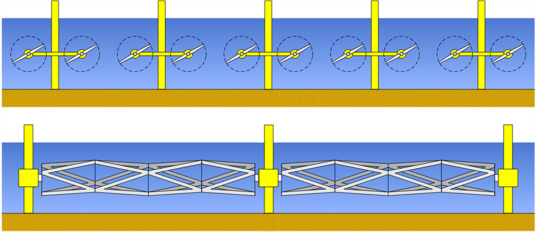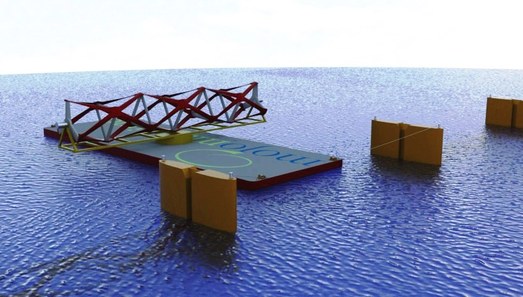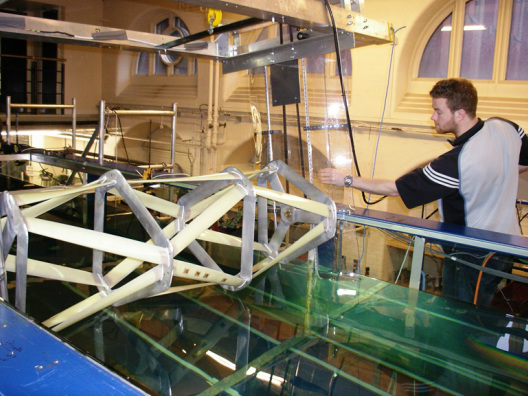There are three key technologies for extracting energy from tidal streams: ‘Conventional’ horizontal axis turbines; Dynamic Tidal Power (DTP), which is being developed by the leading Hydrology Institutes in China in conjunction with a Dutch consortium; and tidal fences, for which the patented Kepler turbine is the leading machine.
The most common design of tidal device is the conventional axial turbine which superficially resembles a wind turbine that has been converted for use underwater. Due to the physical limits of traditional rotor design, the vast majority of these devices have been deployed in deep water (>30m) and high velocity (>2.5m/s) tidal flows. Higher outputs are achieved by using longer blades, but limits due to cavitation are soon reached. This approach has driven the developers to seek the strongest currents, which in turn has led to designs which are very specific to high velocities and deep water, but inefficient at lower velocities, due to the cubic nature of the power relationship. Turbine arrays are expected to be laid out along the line of the tide, positioned to reflect sub-surface conditions.
Dynamic Tidal Power envisages the construction of very long walls or barrages out into the ocean, approximately perpendicular to the coastline, with output magnified using a ‘t-piece’ at the end. The concept originates from The Netherlands, and development is being financed and driven by China.
Very large outputs, in the range of 10-15GW are predicted from a 40-50km wall. However, like a barrage, the structure must first be built in order to ascertain whether it will perform as expected.
A tidal fence envisages a linear, connected series of turbines in a chain, placed to best exploit the available tidal flow. The concept was first promoted in a study for the UK Government entitled Severn Embryonic Technology Scheme (SETS). The writers of the report demonstrated the considerable power output possible from a fence in the Bristol Channel, but concluded that at that time there were no suitable turbines available to exploit the physical phenomenon being used, Blockage. Simply, the fence creates a head, which the turbines can then use by effectively extracting potential energy. It should be noted that the power coefficient of turbines forming a tidal fence is proportional to the length of the fence – so the output for each physical turbine in the fence increases with the length of the fence. This is because the horizontal blockage increases with each additional turbine added.
The most common design of tidal device is the conventional axial turbine which superficially resembles a wind turbine that has been converted for use underwater. Due to the physical limits of traditional rotor design, the vast majority of these devices have been deployed in deep water (>30m) and high velocity (>2.5m/s) tidal flows. Higher outputs are achieved by using longer blades, but limits due to cavitation are soon reached. This approach has driven the developers to seek the strongest currents, which in turn has led to designs which are very specific to high velocities and deep water, but inefficient at lower velocities, due to the cubic nature of the power relationship. Turbine arrays are expected to be laid out along the line of the tide, positioned to reflect sub-surface conditions.
Dynamic Tidal Power envisages the construction of very long walls or barrages out into the ocean, approximately perpendicular to the coastline, with output magnified using a ‘t-piece’ at the end. The concept originates from The Netherlands, and development is being financed and driven by China.
Very large outputs, in the range of 10-15GW are predicted from a 40-50km wall. However, like a barrage, the structure must first be built in order to ascertain whether it will perform as expected.
A tidal fence envisages a linear, connected series of turbines in a chain, placed to best exploit the available tidal flow. The concept was first promoted in a study for the UK Government entitled Severn Embryonic Technology Scheme (SETS). The writers of the report demonstrated the considerable power output possible from a fence in the Bristol Channel, but concluded that at that time there were no suitable turbines available to exploit the physical phenomenon being used, Blockage. Simply, the fence creates a head, which the turbines can then use by effectively extracting potential energy. It should be noted that the power coefficient of turbines forming a tidal fence is proportional to the length of the fence – so the output for each physical turbine in the fence increases with the length of the fence. This is because the horizontal blockage increases with each additional turbine added.

The Kepler tidal turbine consists of a stressed truss configuration of carbon composite hydrofoil blades. The stressed truss feature forms the patented feature of the design, and it is this which gives sufficient structural strength to enable the very large scales envisaged. The basic generating unit comprises two turbines with a central generator, with only four supporting bearings and three foundation supports required. Units can be placed in a fence format to maximise blockage (ratio of device swept area to the cross-sectional area of the flow) effects. From the Kepler turbine picture to the left it can be seen that fewer generators will be used to capture energy from the rotors. In fact, the generator is located in the middle column and is driven by both rotors at the same time, providing an avenue for cost reduction.
The basis for the Kepler turbine’s advantage is two-fold. First, being a transverse horizontal turbine, its swept area will be greater than a horizontal series of axial turbines, which will themselves be limited in rotor diameter by the depth of water. Secondly, it is able to exploit the blockage phenomenon, which boosts the power output by effectively creating a ‘head’ and then exploiting potential energy. This phenomenon has been explored in great detail both in theory (see for example ‘Application of Linear Momentum Actuator Disc Theory to Open Channel Flow’, G.T. Houlsby, S. Draper and M.L.G. Oldfield) and in testing of the first two prototypes, results of which have been published extensively, for example at EWTEC and Proceedings of the Royal Society of Arts, as well as in a Doctoral thesis. Click here to review some of the key papers.
The basis for the Kepler turbine’s advantage is two-fold. First, being a transverse horizontal turbine, its swept area will be greater than a horizontal series of axial turbines, which will themselves be limited in rotor diameter by the depth of water. Secondly, it is able to exploit the blockage phenomenon, which boosts the power output by effectively creating a ‘head’ and then exploiting potential energy. This phenomenon has been explored in great detail both in theory (see for example ‘Application of Linear Momentum Actuator Disc Theory to Open Channel Flow’, G.T. Houlsby, S. Draper and M.L.G. Oldfield) and in testing of the first two prototypes, results of which have been published extensively, for example at EWTEC and Proceedings of the Royal Society of Arts, as well as in a Doctoral thesis. Click here to review some of the key papers.

The overall production design concept has been developed by Kepler and by its Supply Chain, and is production ready. For example, the image to the left shows how the rotor will be installed using simple, existing marine technology.

The research program was undertaken at the Newcastle University flume, and supported by the Technology Strategy Board. The image to the left shows the 1:20 model THAWT rotor being lowered into the test flume before power and stress measurements.
With the significant attributes that it presents, the Kepler turbine is a disruptive technology in terms of the way it completely changes the economics of tidal generation and unlocks the full potential of ocean energy which cannot be exploited by any other means.
With the significant attributes that it presents, the Kepler turbine is a disruptive technology in terms of the way it completely changes the economics of tidal generation and unlocks the full potential of ocean energy which cannot be exploited by any other means.